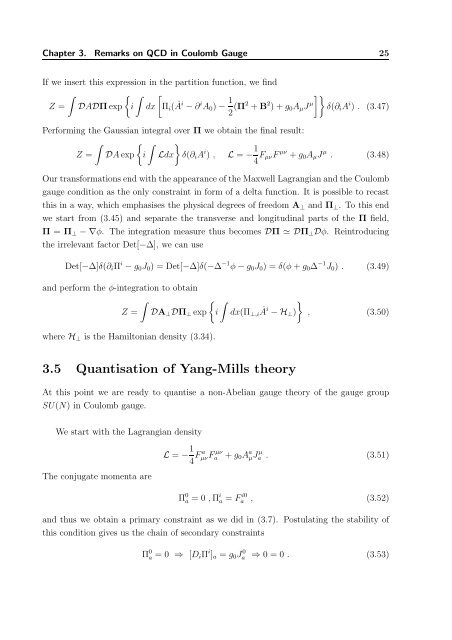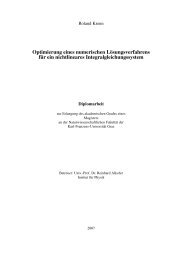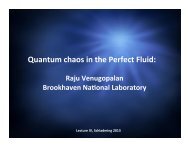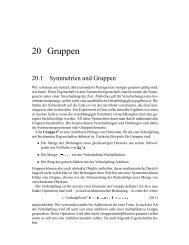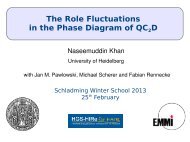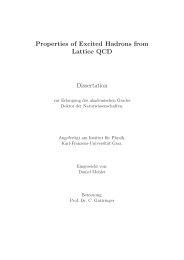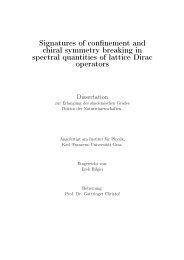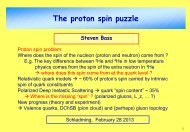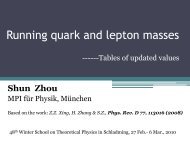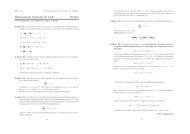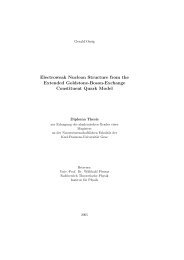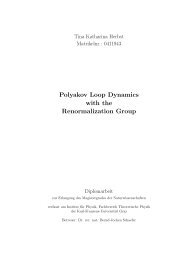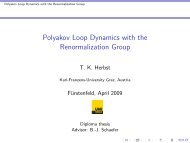The QCD Quark Propagator in Coulomb Gauge and - Institut für Physik
The QCD Quark Propagator in Coulomb Gauge and - Institut für Physik
The QCD Quark Propagator in Coulomb Gauge and - Institut für Physik
You also want an ePaper? Increase the reach of your titles
YUMPU automatically turns print PDFs into web optimized ePapers that Google loves.
Chapter 3. Remarks on <strong>QCD</strong> <strong>in</strong> <strong>Coulomb</strong> <strong>Gauge</strong> 25<br />
If we <strong>in</strong>sert this expression <strong>in</strong> the partition function, we f<strong>in</strong>d<br />
∫ { ∫ [<br />
Z = DADΠ exp i dx Π i ( A ˙i<br />
− ∂ i A 0 ) − 1 2 (Π2 + B 2 ) + g 0 A µ J<br />
]}δ(∂ µ i A i ) . (3.47)<br />
Perform<strong>in</strong>g the Gaussian <strong>in</strong>tegral over Π we obta<strong>in</strong> the f<strong>in</strong>al result:<br />
∫ { ∫ }<br />
Z = DA exp i Ldx δ(∂ i A i ) , L = − 1 4 F µνF µν + g 0 A µ J µ . (3.48)<br />
Our transformations end with the appearance of the Maxwell Lagrangian <strong>and</strong> the <strong>Coulomb</strong><br />
gauge condition as the only constra<strong>in</strong>t <strong>in</strong> form of a delta function. It is possible to recast<br />
this <strong>in</strong> a way, which emphasises the physical degrees of freedom A ⊥ <strong>and</strong> Π ⊥ . To this end<br />
we start from (3.45) <strong>and</strong> separate the transverse <strong>and</strong> longitud<strong>in</strong>al parts of the Π field,<br />
Π = Π ⊥ − ∇φ. <strong>The</strong> <strong>in</strong>tegration measure thus becomes DΠ ≃ DΠ ⊥ Dφ. Re<strong>in</strong>troduc<strong>in</strong>g<br />
the irrelevant factor Det[−∆], we can use<br />
Det[−∆]δ(∂ i Π i − g 0 J 0 ) = Det[−∆]δ(−∆ −1 φ − g 0 J 0 ) = δ(φ + g 0 ∆ −1 J 0 ) . (3.49)<br />
<strong>and</strong> perform the φ-<strong>in</strong>tegration to obta<strong>in</strong><br />
∫<br />
Z = DA ⊥ DΠ ⊥ exp<br />
{ ∫<br />
i<br />
}<br />
dx(Π ⊥,i Ȧ i − H ⊥ )<br />
, (3.50)<br />
where H ⊥ is the Hamiltonian density (3.34).<br />
3.5 Quantisation of Yang-Mills theory<br />
At this po<strong>in</strong>t we are ready to quantise a non-Abelian gauge theory of the gauge group<br />
SU(N) <strong>in</strong> <strong>Coulomb</strong> gauge.<br />
We start with the Lagrangian density<br />
<strong>The</strong> conjugate momenta are<br />
L = − 1 4 F a µνF µν<br />
a + g 0 A a µJ µ a . (3.51)<br />
Π 0 a = 0 , Πi a = F i0<br />
a , (3.52)<br />
<strong>and</strong> thus we obta<strong>in</strong> a primary constra<strong>in</strong>t as we did <strong>in</strong> (3.7). Postulat<strong>in</strong>g the stability of<br />
this condition gives us the cha<strong>in</strong> of secondary constra<strong>in</strong>ts<br />
Π 0 a = 0 ⇒ [D iΠ i ] a = g 0 J 0 a ⇒ 0 = 0 . (3.53)


